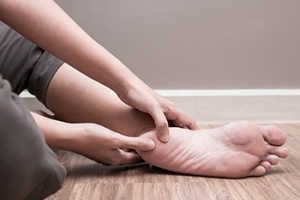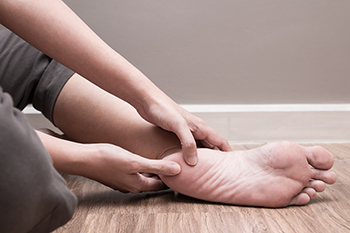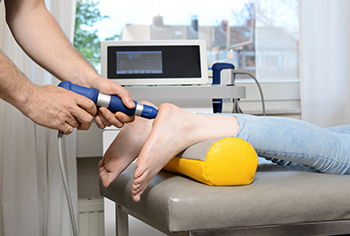Garner (919) 661-4150
Why Do I Have Foot Pain?
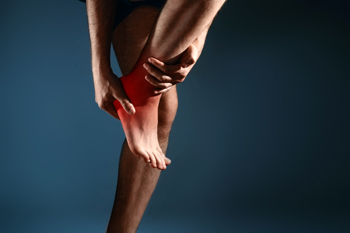
The foot is one of the most important parts of the human body. Not only is it responsible for bearing the weight of your body, but it is also central to movement such as walking and running. When you experience foot pain it is nothing to take lightly, and your body may be indicating something isn’t right. There could be several reasons why your foot is hurting. First, you might be having foot pain as a result of a fungal infection. For example, you may have developed a condition known as athlete’s foot, which makes the affected skin flaky and itchy. Second, you could be suffering from an overuse injury. This commonly occurs in athletes who repeatedly put pressure and strain on their feet when running and jumping. Third, you might be experiencing foot pain because of a fracture. Bones in the feet can become fractured, or broken, when heavy objects are dropped on the feet or when being subject to repeated trauma. If your feet are hurting, contact a podiatrist.
Foot Pain
Foot pain can be extremely painful and debilitating. If you have a foot pain, consult with Chukwuma Ukata, DPM from Advanced Carolina Foot and Ankle Center. Our doctor will assess your condition and provide you with quality foot and ankle treatment.
Causes
Foot pain is a very broad condition that could be caused by one or more ailments. The most common include:
- Bunions
- Hammertoes
- Plantar Fasciitis
- Bone Spurs
- Corns
- Tarsal Tunnel Syndrome
- Ingrown Toenails
- Arthritis (such as Gout, Rheumatoid, and Osteoarthritis)
- Flat Feet
- Injury (from stress fractures, broken toe, foot, ankle, Achilles tendon ruptures, and sprains)
- And more
Diagnosis
To figure out the cause of foot pain, podiatrists utilize several different methods. This can range from simple visual inspections and sensation tests to X-rays and MRI scans. Prior medical history, family medical history, and any recent physical traumatic events will all be taken into consideration for a proper diagnosis.
Treatment
Treatment depends upon the cause of the foot pain. Whether it is resting, staying off the foot, or having surgery; podiatrists have a number of treatment options available for foot pain.
If you have any questions, please feel free to contact our office located in Garner, NC . We offer the newest diagnostic and treatment technologies for all your foot care needs.
Heel Pain, Plantar Fasciitis, and Obesity May Be Connected
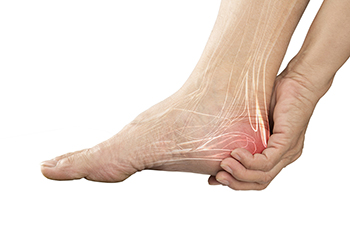
Research has indicated there is a large percentage of Americans that are considered to be obese. This condition is known to increase the risk of many physical ailments, including heel pain and plantar fasciitis. It can happen as a result of the added impact the feet endure from completing daily activities, and this may possibly damage the plantar fascia. This is defined as the band of tissue that runs along the bottom of the foot, and connects the heels to the toes. Walking can become difficult, and heel pain may increase. Partial relief may be found when a low-impact exercise routine is frequently followed. This type of exercise can include swimming, water aerobics or cycling, and some patients can feel the benefits of practicing yoga and Pilates as part of their exercise regime. This, along with eating foods that are healthy, are often effective ways to lose weight, which may relieve some of the pressure on the plantar fascia. If you have any type of foot pain, and feel your weight may be a contributing factor, please speak with a podiatrist who can treat foot conditions, and offer additional solutions for weight loss.
The more you weigh, the harder your feet must work to support your body. If you’re an obese individual and are concerned about your feet, contact Chukwuma Ukata, DPM from Advanced Carolina Foot and Ankle Center. Our doctor can provide the care you need to keep you pain-free and on your feet.
Obesity and Your Feet
People who are overweight are putting more pressure on their ankles, knees, and hips as well as their feet. This unfortunately can lead to variety of different issues.
Problems & Complications Stemming from Obesity
- When the body is overweight, it tries to compensate by changing the way that it moves. An obese person may lean forward and put extra weight on the wrong part of the foot. This puts unnecessary stress on the feet.
- Obese people are also more likely to develop type II diabetes which is a condition that causes a lot of foot problems. People with diabetes often don’t feel the cuts and sores that they may have on their feet, which can lead to more complicated and severe issues.
- Plantar fasciitis is another foot condition that can be caused by obesity. Plantar fasciitis is an inflammation of the tissue along the bottom of the foot, which causes pain and stiffness while walking and climbing stairs.
If you have any questions, please feel free to contact our office located in Garner, NC . We offer the newest diagnostic and treatment technologies for all your foot care needs.
What Is Cuboid Syndrome?
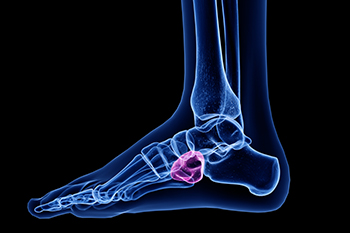
Cuboid syndrome is a condition that involves a disruption of the normal alignment of the cuboid bone with the heel bone, and it causes pain on the outside of the foot. The pain might feel like it originates from the outside of the ankle, and the person afflicted with it may limp or sway when walking to avoid placing weight on the affected area. Mild swelling or bruising might be seen on the outside and bottom of the mid-foot. This problem develop from a single event, such as an ankle sprain, or through repetitive impact to the area, like runners or dancers (particularly ballet dancers) might experience. A small “popping” might be felt on the outside of the mid-foot as well. Treatment of cuboid syndrome usually involves making sure shoes are well-fitting and comfortable, using soft orthotics, and doing stretching exercises to help mobilize the joint. In some instances, realignment of the cuboid bone is needed. If you feel pain in your mid-foot area and it is worsening, you might have a more severe case of cuboid syndrome. You can see a podiatrist who can properly diagnose the problem and provide appropriate treatment.
Cuboid syndrome, also known as cuboid subluxation, occurs when the joints and ligaments near the cuboid bone in the foot become torn. If you have cuboid syndrome, consult with Chukwuma Ukata, DPM from Advanced Carolina Foot and Ankle Center. Our doctor will assess your condition and provide you with quality foot and ankle treatment.
Cuboid syndrome is a common cause of lateral foot pain, which is pain on the outside of the foot. The condition may happen suddenly due to an ankle sprain, or it may develop slowly overtime from repetitive tension through the bone and surrounding structures.
Causes
The most common causes of cuboid syndrome include:
- Injury – The most common cause of this ailment is an ankle sprain.
- Repetitive Strain – Tension placed through the peroneus longus muscle from repetitive activities such as jumping and running may cause excessive traction on the bone causing it to sublux.
- Altered Foot Biomechanics – Most people suffering from cuboid subluxation have flat feet.
Symptoms
A common symptom of cuboid syndrome is pain along the outside of the foot which can be felt in the ankle and toes. This pain may create walking difficulties and may cause those with the condition to walk with a limp.
Diagnosis
Diagnosis of cuboid syndrome is often difficult, and it is often misdiagnosed. X-rays, MRIs and CT scans often fail to properly show the cuboid subluxation. Although there isn’t a specific test used to diagnose cuboid syndrome, your podiatrist will usually check if pain is felt while pressing firmly on the cuboid bone of your foot.
Treatment
Just as the range of causes varies widely, so do treatments. Some more common treatments are ice therapy, rest, exercise, taping, and orthotics.
If you have any questions, please feel free to contact our office located in Garner, NC . We offer the newest diagnostic and treatment technologies for all your foot care needs.
All About Cuboid Syndrome
Though cuboid syndrome predominately affects athletes, non-athletes can suffer from it too. Cuboid syndrome is also called cuboid subluxation or cuboid fault syndrome, and occurs when a joint or ligament near the cuboid bone of the foot becomes damaged, or when the bone itself is dislodged from its natural position. Pain may be persistent, or come and go, and it is usually marked by the outside of the foot. Cuboid syndrome, unless severe, can be difficult to diagnose. A doctor will likely ask questions about how long the pain has been present, and will apply pressure on the cuboid bone to determine the origin of pain.
There are a number of causes that can lead to the syndrome. Due to athletic activities, repeated stress placed on the foot can cause cuboid subluxation. Ballet dancers, runners, and other athletes often develop this condition. Basketball or tennis players may also develop this condition, as they place stress on their feet while moving side to side. Cuboid syndrome can often develop over time; however it can come out of a sudden injury as well. Over pronation, or other problems with feet, can exacerbate the condition if not corrected.
Among podiatrists, there is some disagreement about the treatment, as well as the definition of cuboid syndrome. Some see the injury as an injury to the ligaments located nearby the cuboid bone, while others believe it refers to the dislocation of the calcaneal-cuboid joint only. Treatment opinions differ as well. Although it can be treated by manipulation in order to reposition the bone, this must be done with extreme care in order to avoid injury. Some doctors, however, prefer treatment through the use of orthotic pads, designed to keep the bone in its place. Effectiveness of these treatments may vary, according to the severity of the injury.
When you experience side foot pain, it is important that you seek medical assistance. If a subluxed cuboid is caught and treated early, treatment is usually successful, and individuals may begin activities such as sports when the pain subsides. If left untreated, the pain will worsen, and the condition could cause permanent damage.
Ankle Arthritis Can Cause Severe Pain
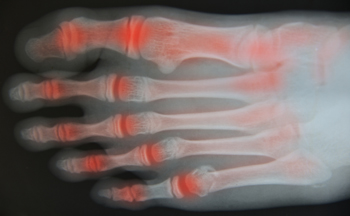
Arthritis in the feet can be a debilitating condition and it may occur from a prior injury to the ankle, obesity, or joint infection. Additionally, rheumatoid disease may lead to ankle arthritis and this may be a result of inflammation of the joint cartilage. Research has shown there are three stages of ankle arthritis. Many patients tend to ignore symptoms in the first stage and will gradually feel the pain while moving the ankle. It is often possible to perform specific exercises during this stage, and this may help to alleviate some of the discomforts. It becomes increasingly difficult to ignore the symptoms during stage two and severe pain and discomfort can occur while walking or running. During stage three, the cartilage is almost completely gone and there is often friction between the bones due to reduced lubricating fluids. There are several treatment options for ankle arthritis including arch supports for the feet, controlling body weight to help reduce pressure on the ankle joints, and performing ankle exercises. If you have ankle pain and think it may be arthritis, it is suggested to consult with a podiatrist who can effectively treat this condition.
Arthritis can be a difficult condition to live with. If you are seeking treatment, contact Chukwuma Ukata, DPM from Advanced Carolina Foot and Ankle Center. Our doctor can provide the care you need to keep you pain-free and on your feet.
Arthritic Foot Care
Arthritis is a term that is commonly used to describe joint pain. The condition itself can occur to anyone of any age, race, or gender, and there are over 100 types of it. Nevertheless, arthritis is more commonly found in women compared to men, and it is also more prevalent in those who are overweight. The causes of arthritis vary depending on which type of arthritis you have. Osteoarthritis for example, is often caused by injury, while rheumatoid arthritis is caused by a misdirected immune system.
Symptoms
- Swelling
- Pain
- Stiffness
- Decreased Range of Motion
Arthritic symptoms range in severity, and they may come and go. Some symptoms stay the same for several years but could potentially get worse with time. Severe cases of arthritis can prevent its sufferers from performing daily activities and make walking difficult.
Risk Factors
- Occupation – Occupations requiring repetitive knee movements have been linked to osteoarthritis
- Obesity – Excess weight can contribute to osteoarthritis development
- Infection – Microbial agents can infect the joints and trigger arthritis
- Joint Injuries – Damage to joints may lead to osteoarthritis
- Age – Risk increases with age
- Gender –Most types are more common in women
- Genetics – Arthritis can be hereditary
If you suspect your arthritis is affecting your feet, it is crucial that you see a podiatrist immediately. Your doctor will be able to address your specific case and help you decide which treatment method is best for you.
If you have any questions, please feel free to contact our office located in Garner, NC . We offer the newest diagnostic and treatment technologies for all your foot care needs.
How to Care for Your Arthritic Foot
Arthritis is an inflammation of the joints and it can occur at any joint in the body, especially in the foot. It generally effects those who are older, however, it can occur at any age. Although there are many different forms of arthritis, there are three main types that occur in the foot. The three types are osteoarthritis, rheumatoid arthritis, and gout.
The primary cause of osteoarthritis is aging. As you age, cartilage degenerates around the joints which causes friction and pain. Obesity can cause osteoarthritis through mechanical stress. Injuries that damage joints can increase the probability as well. Finally, a family history of osteoarthritis can also increase chances of having it.
Rheumatoid arthritis occurs when the immune system attacks the joint linings and weakens them over a long time. While there is no known cause of rheumatoid arthritis, obesity and smoking can increase your chances of getting it. Women are also more likely to get it than men.
Gout is a form of arthritis that occurs when there is too much uric acid in your blood and painful crystals form in your joints. Men are more likely to have gout than women. People who are obese or drink alcohol often are also more likely to develop gout. Furthermore, having diabetes, heart disease, high blood pressure, high cholesterol, gastric bypass surgery or a family history of gout may increase your likelihood of developing the condition.
Symptoms of arthritis include pain, stiffness, swelling in the joints. These symptoms can make it harder and more painful to walk. Physical activity can increase pain and discomfort. Furthermore, joint pain can worsen throughout the day for osteoarthritis. Gout attacks generally last several days with the first few being the worst.
Diagnosis of gout includes either a joint fluid test or a blood test. X-ray imaging can detect osteoarthritis but not gout. On the other hand, there is no blood test for osteoarthritis. Rheumatoid arthritis is difficult to diagnosis. Doctors utilize family and personal medical history, a physical examination, and antibody blood tests to determine if you have rheumatoid arthritis.
Treatment varies for the different kinds of arthritis. Anti-inflammatory medication or steroids can help reduce pain from inflammation of the joints. Changing shoe types can help with some symptoms. Wider shoes can help with discomfort from gout and osteoarthritis. High heels should be avoided. Shoes with proper arch support and that take pressure off the ball of the foot can help with rheumatoid arthritis. Drinking lots of water can also help rid uric acid from the blood. Losing weight, improving your diet, and limiting alcohol and smoking can also help prevent or lessen the symptoms of arthritis.
If you are having trouble walking or pain in your feet, see a podiatrist to check if you have arthritis.
Why Fungal Nails Can Be Difficult to Treat
Fungal toenail infections are a common occurrence, particularly in people over the age of 70. This type of infection, medically referred to as onychomycosis, can embed itself within the multiple layers that make toenails as well as their underlying nail beds. This is one of the reasons why killing the fungus that causes the infection can be so difficult. Another reason is that the fungal organism is highly contagious and can live for months in the warm, moist environments it thrives in (locker rooms, communal showers, bathrooms, enclosed shoes, swimming areas, etc.). It can be transmitted easily onto bare feet, or by wearing wet socks or shoes, and from direct contact with someone who is infected. Nails that are infected by a fungal organism can become thickened, brittle, crumbly, discolored, deformed, and even painful. Depending on the severity of the infection, a podiatrist can use various methods of treatment to eradicate the fungus, prevent it from returning, and help the natural nail to regrow.
For more information about treatment, contact Chukwuma Ukata, DPM of Advanced Carolina Foot and Ankle Center. Our doctor can provide the care you need to keep you pain-free and on your feet.
Toenail Fungus Treatment
Toenail fungus is a condition that affects many people and can be especially hard to get rid of. Fortunately, there are several methods to go about treating and avoiding it.
Antifungals & Deterrence
Oral antifungal medicine has been shown to be effective in many cases. It is important to consult with a podiatrist to determine the proper regiment for you, or potentially explore other options.
Applying foot powder on the feet and shoes helps keep the feet free of moisture and sweat.
Sandals or open toed shoes – Wearing these will allow air movement and help keep feet dry. They also expose your feet to light, which fungus cannot tolerate. Socks with moisture wicking material also help as well.
If you have any questions please feel free to contact our office located in Garner, NC . We offer the newest diagnostic tools and technology to treat your foot and ankle needs.
A Common Form of Heel Pain
The plantar fascia is a strong supportive tissue that runs under the arch of the foot, connecting the heel to the base of the toes. It helps distribute weight evenly across the foot which enables us to walk and run with ease. If the plantar fascia gets stretched or stressed excessively, it can become painful and inflamed. This condition is known as plantar fasciitis. Certain factors that contribute to this condition include wearing shoes that don’t support or cushion the feet properly, having low or high arches, being obese, increasing the intensity of workouts abruptly or exercising on a hard surface, standing for prolonged periods of time, and old age. In addition to creating heel pain which usually is at its worst in the morning or after periods of rest, plantar fasciitis can increase the likelihood of calcium deposits forming on the heel bone (heel spurs). Podiatrists have a great deal of experience treating plantar fasciitis as it is the most common form of heel pain. Reach out to a podiatrist if you believe you have plantar fasciitis to get on the road to recovery.
Plantar fasciitis can be very painful and inconvenient. If you are experiencing heel pain or symptoms of plantar fasciitis, contact Chukwuma Ukata, DPM from Advanced Carolina Foot and Ankle Center. Our doctor can provide the care you need to keep you pain-free and on your feet.
What Is Plantar Fasciitis?
Plantar fasciitis is the inflammation of the thick band of tissue that runs along the bottom of your foot, known as the plantar fascia, and causes mild to severe heel pain.
What Causes Plantar Fasciitis?
- Excessive running
- Non-supportive shoes
- Overpronation
- Repeated stretching and tearing of the plantar fascia
How Can It Be Treated?
- Conservative measures – anti-inflammatories, ice packs, stretching exercises, physical therapy, orthotic devices
- Shockwave therapy – sound waves are sent to the affected area to facilitate healing and are usually used for chronic cases of plantar fasciitis
- Surgery – usually only used as a last resort when all else fails. The plantar fascia can be surgically detached from the heel
While very treatable, plantar fasciitis is definitely not something that should be ignored. Especially in severe cases, speaking to your doctor right away is highly recommended to avoid complications and severe heel pain. Your podiatrist can work with you to provide the appropriate treatment options tailored to your condition.
If you have any questions please feel free to contact our office located in Garner, NC . We offer the newest diagnostic and treatment technologies for all your foot and ankle needs.
Ankle Sprains and Chronic Ankle Instability
 If you have ever had an ankle sprain, it is likely an experience that you wouldn’t want to repeat. Yet spraining your ankle once can make future ankle sprains more likely. In some individuals, the sprained ankle doesn’t heal fully. This not only increases the risk for future sprains, but can also cause chronic ankle instability. Chronic ankle instability is characterized by ankle pain, swelling, tenderness, stiffness, and repeated sensations of the ankle “giving out.” The ankle instability can be caused by excessively lax ligaments, or deficits in the nerves and muscles surrounding the ankles. If you are prone to ankle sprains, don’t live with chronic pain. Please seek the care of a podiatrist for a proper diagnosis and treatment.
If you have ever had an ankle sprain, it is likely an experience that you wouldn’t want to repeat. Yet spraining your ankle once can make future ankle sprains more likely. In some individuals, the sprained ankle doesn’t heal fully. This not only increases the risk for future sprains, but can also cause chronic ankle instability. Chronic ankle instability is characterized by ankle pain, swelling, tenderness, stiffness, and repeated sensations of the ankle “giving out.” The ankle instability can be caused by excessively lax ligaments, or deficits in the nerves and muscles surrounding the ankles. If you are prone to ankle sprains, don’t live with chronic pain. Please seek the care of a podiatrist for a proper diagnosis and treatment.
Ankle sprains are common but need immediate attention. If you need your feet checked, contact Chukwuma Ukata, DPM from Advanced Carolina Foot and Ankle Center. Our doctor can provide the care you need to keep you pain-free and on your feet.
How Does an Ankle Sprain Occur?
Ankle sprains take place when the ligaments in your ankle are torn or stretched beyond their limits. There are multiple ways that the ankle can become injured, including twisting or rolling over onto your ankle, putting undue stress on it, or causing trauma to the ankle itself.
What Are the Symptoms?
- Mild to moderate bruising
- Limited mobility
- Swelling
- Discoloration of the skin (depending on severity)
Preventing a Sprain
- Wearing appropriate shoes for the occasion
- Stretching before exercises and sports
- Knowing your limits
Treatment of a Sprain
Treatment of a sprain depends on the severity. Many times, people are told to rest and remain off their feet completely, while others are given an air cast. If the sprain is very severe, surgery may be required.
If you have suffered an ankle sprain previously, you may want to consider additional support such as a brace and regular exercises to strengthen the ankle.
If you have any questions please feel free to contact our office located in Garner, NC . We offer the newest diagnostic and treatment technologies for all your foot and ankle needs.
What Is Extracorporeal Shock Wave Therapy (ESWT)?
In Extracorporeal Shock Wave Therapy (ESWT), a handheld device sends a series of acoustic pulses through the surface of the skin to an area of damaged tissue. This intense energy creates a microtrauma in the injured tissue, causing the body to respond by increasing blood circulation and metabolism. This accelerates the body’s natural healing response, helps the body to produce new cells, and reduces pain. Shockwave therapy is a non-invasive treatment with minimal side effects. The treatments only take a couple of minutes and are usually administered once a week for 3-4 weeks or more, depending on the level of damage/pain and how long it has been present. Shockwave therapy can be very effective in the treatment of plantar fasciitis, Achilles tendinopathy, and more. Contact your podiatrist to see if your condition may be treated with ESWT.
Shockwave therapy is a treatment commonly used to treat various injuries and conditions, particularly plantar fasciitis in the feet. To learn more, consult with Chukwuma Ukata, DPM from Advanced Carolina Foot and Ankle Center. Our doctor can provide the care you need to keep you pain-free and on your feet.
Shockwave Therapy
Shockwave therapy is a new treatment option designed to treat bone conditions such as tennis elbow, shoulder pain, and others. Shockwave therapy uses high intensity sound waves that are directed to the affected tissues of the body with pinpoint accuracy. The effects are very beneficial, leading to a production of collagen fibers, eliminating inflammation.
Who Benefits from Shockwave?
Shockwave is recommended for patients suffering from heel pain and associated problems. Heel pain is a common condition which can be caused by obesity, overexertion, and spending a substantial amount of time on hard floors with your feet exposed and unsupported.
Fast and Easy
The therapy is actually a simple process that can leave patients feeling better the very next day. Shockwave therapy is not as dramatic as it sounds. It enables more blood flow to effected areas, addressing the source of the problem and allowing treatment to last for a long time.
Treatment & Recovery Time
Shockwave treatment will enable your feet to recover quickly. This is especially important since surgery is not required. It is cost effective and does not require the use of anesthesia. This treatment is a better option to surgery, since it is proven safe.
If you have any questions, please feel free to contact our office located in Garner, NC . We offer the newest diagnostic and treatment technologies for all your foot and ankle needs.







